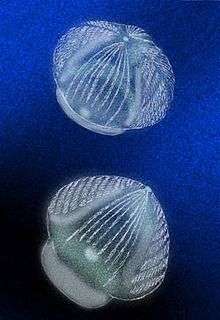Fasciculus
Fasciculus vesanus is an extinct species of stem-group ctenophores, known from the Burgess Shale of British Columbia, Canada. It is dated to 515 to 505 million years ago and belongs to middle Cambrian strata.[1]
| Fasciculus vesanus | |
|---|---|
 | |
| Artist's reconstruction | |
| Scientific classification | |
| Kingdom: | Animalia |
| Phylum: | Ctenophora |
| Genus: | †Fasciculus Simonetta & Delle Cave, 1978 |
| Species: | †F. vesanus |
| Binomial name | |
| †Fasciculus vesanus Simonetta & Delle Cave, 1978 | |
The species is remarkable for its two sets of long and short comb rows, not seen in similar form elsewhere in the fossil record or among modern species.
See also
- Ctenorhabdotus capulus
- Xanioascus canadensis
Maotianshan shales ctenophores
- Maotianoascus octonarius
- Sinoascus paillatus
- Stromatoveris psygmoglena
External links
- "Fasciculus vesanus". Burgess Shale Fossil Gallery. Virtual Museum of Canada. 2011.
References
- S. Conway Morris & D. H. Collins. "Middle Cambrian ctenophores from the Stephen Formation, British Columbia, Canada". Philosophical Transactions of the Royal Society B: Biological Sciences. 351 (1337): 243–360. doi:10.1098/rstb.1996.0024. JSTOR 56388.
This article is issued from Wikipedia. The text is licensed under Creative Commons - Attribution - Sharealike. Additional terms may apply for the media files.